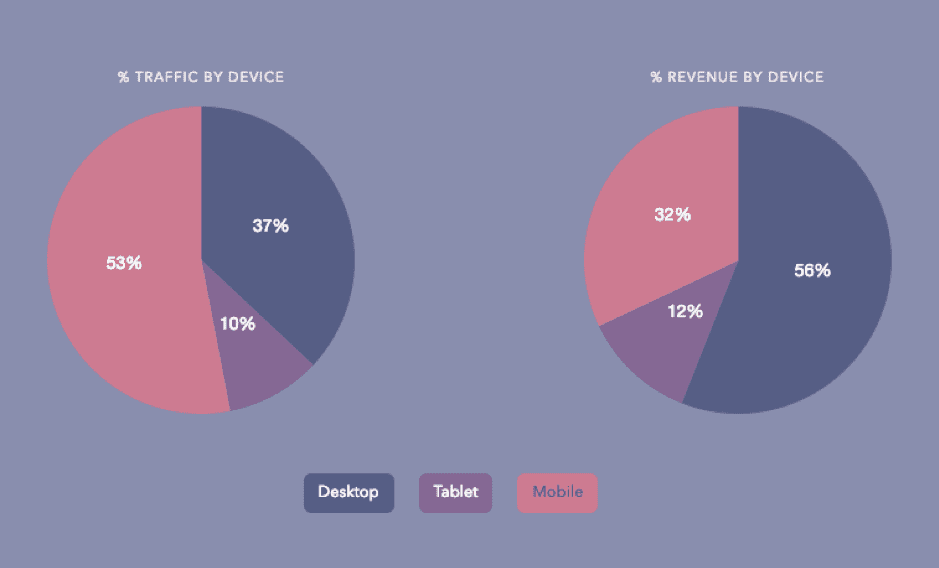It’s time to explore five key email marketing trends set to shape your strategy in 2020, from mobile optimization and simplified content, to AI and email’s continued position as one of the most trusted communication channels available to marketers
As 2019 draws to a close, it’s time to start looking ahead to what 2020 may bring with our annual series of blogs dedicated to the biggest marketing trends for the year ahead.
Outside the world of marketing, things are increasingly unpredictable. Rewind back to 2010 and you’d be hard-pressed to find anybody capable of predicting the decade that was about to unfold.
Luckily for us, however, marketing trends – and digital trends, in particular – are slightly more predictable. With the amount of data we have at our fingertips, it’s now easier to know which tools, tactics and technologies are working and which are becoming less effective.
For this blog, we’re joined by a selection of the world’s leading email marketers who have identified their key email marketing trends to stay on top of in 2020 and beyond.
Email marketing has defied its critics in continuing to provide an array of benefits to marketers, from building trust to providing some of the greatest ROIs of any digital channel.
Faced with the booming popularity of social media and search, email still serves up a distinct set of benefits that other media streams struggle to match, but there are developments on the horizon that you need to be prepared for…
It’s time to think mobile
Across your digital marketing channels, you’ll be noticing changes that are designed not just to optimize for mobile, but to even prioritize mobile as we move into 2020.
Mobile browsing has now surpassed desktop browsing in terms of percentage traffic:
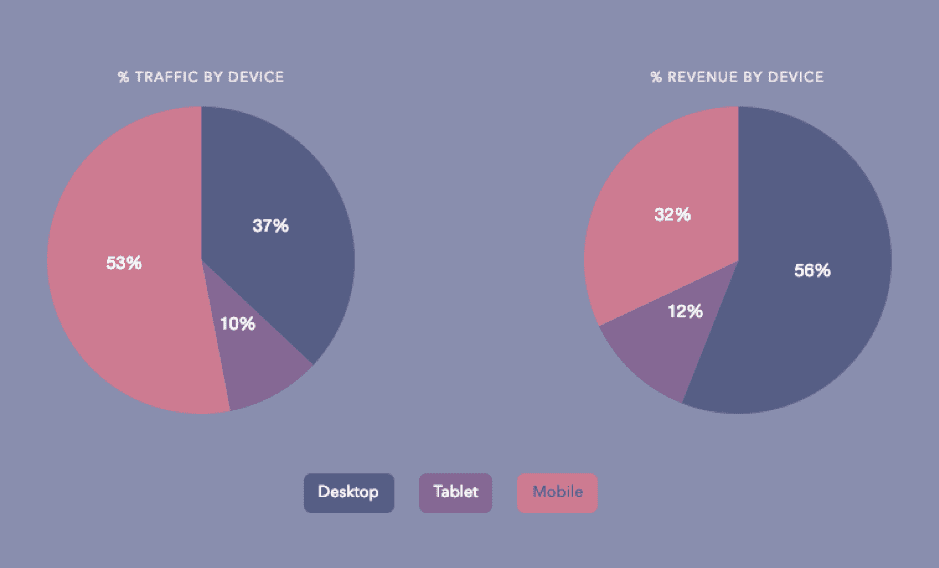
This percentage share of traffic for mobile is not, for now, being matched in terms of where the majority of purchases are being made. Crucially, however, mobile’s percentage revenue has increased by 23% year-on-year, resulting in an acceleration of mobile optimization across almost every digital marketing channel.
Research of this kind, exploring how consumers are surfing the web and purchasing in the digital space, has been the driver behind an array of mobile-focused changes:
- Accelerated mobile pages (AMPs)
- Rich Communication Services (RCS) messaging
- The steady increase in SMS marketing’s popularity
- Mobile-first web design
All of these developments are, quite simply, responses to changes in the way we’re using technology and the internet. With this in mind, as email marketers, you cannot rest on your laurels when it comes to mobile optimization.

The majority of research carried out into email open rates has now concluded that mobile is providing a greater number of email opens than desktop, mirroring mobile shifts across the digital marketing spectrum.
Mobile optimization is not a simple process since the coding behind your emails is important in allowing them to collapse down into a mobile-viewable format. For most email marketers though, the area where you can make instant improvements to optimize for mobile is in your copy, images and overall design and layout.
You want your email copy to do enough to encourage a click-through, but you should also ask yourself what information you can withhold in order to make the copy concise enough for mobile viewing.
After all, most emails are essentially link sources for landing pages, blogs or product pages. Do you really need to include all of the information at this stage or could you save some for the next step of the journey?
In a recent partner email of ours, you can see how short copy can provide both a cleanly presented email on desktop and an optimized experience for subscribers opening the email on mobile:
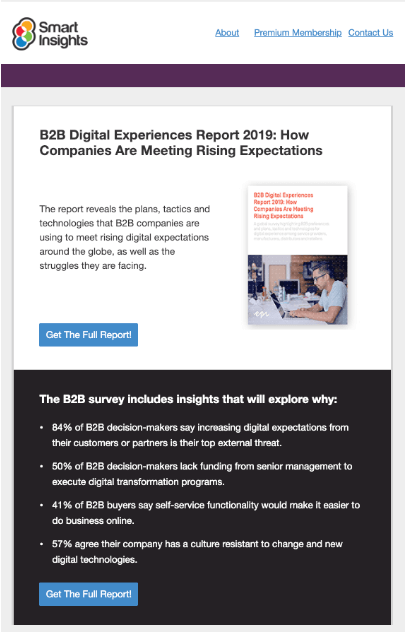
This report is concisely described in the copy, meaning there is sufficient white space to create an easy reading experience on desktop.
The benefits of this kind of copy are even clearer when you view the email on mobile:
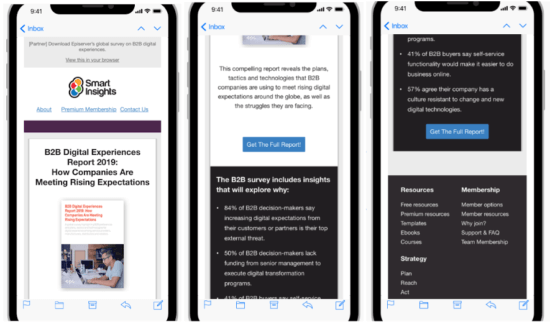
- The image appears on the first fold to encourage further scrolling.
- Concise copy means the first CTA is seen early, on the second fold, so the recipient doesn’t have to scroll through fold-after-fold of heavy copy before they reach a CTA button (copy that could be held back and used on the landing page instead).
- For mobile viewers, who are often on the go when scrolling through emails, the shorter copy can be scanned in no time whatsoever.
- The image dimensions are small enough to render successfully in the email version. Large images often appear correctly on desktop but cause major issues on mobiles with their restricted, and highly varied, viewports.
The process of rendering has always been important when sending mass email communications. For reviewing the mobile viewing experience, however, rendering is now of even greater importance.
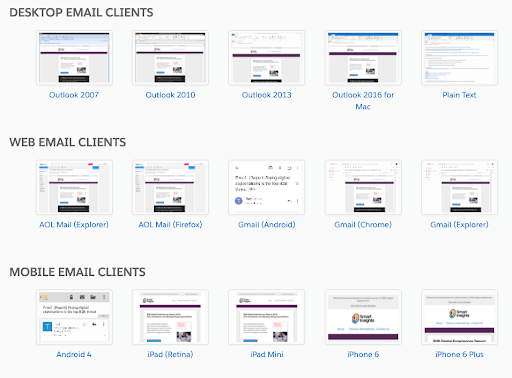
Most email service providers give you the ability to render emails across a range of devices, so it’s worth checking that your emails are providing a suitable user experience across all devices (and not just desktop when sending test emails to your work computer).
Testing has always been an indispensable step in the sending process. Now that emails can be viewed across so many different devices, however, you should be taking the time to guarantee that your emails are rendering across every device type.

Joolz Joseph FCIM MIDM is an Email Consultant and Trainer with over 25 years of sales and marketing experience. Visit www.joolzjoseph.com for more information.
“When testing emails now, it is important to test on a mobile and really put yourself in your recipient’s shoes – they’ll probably be glancing through things on their phone with very little time to truly read it, unless something grabs their attention quickly! Are you making an impact quickly enough?”
This doesn’t just apply to email testing – across your digital marketing, you should consider exactly how the changes you are making will affect your users.
Whichever channel is being used to interact with your business, you need to be certain that the user experience for that channel has been tested across different devices, email clients and browsers.
As for grabbing attention quickly, Joolz also makes a very important point, tying right back into the argument for simple, mobile-optimized copy. Make your point quickly and concisely and you can benefit from higher engagement rates right across your email marketing campaigns.
Less is more in email copy and design
Superfluous copy is a bugbear of all copywriters. With the shift towards mobile usability and readability, concise copy and clear design are now paramount.

The examples above, courtesy of Reader’s Digest, are exactly the types of copy that will lead to readers switching off midway through an email.
It’s understandable that not all companies have dedicated copywriters or UX design experts in-house. If you’re getting by on limited resources though, then you can start improving the returns you achieve from email marketing through the simple process of simplification.
Building on her previous comment, Joolz adds:
“With recipients leading increasingly busy lives and a tendency to read emails on the go, there is a trend towards simpler email design, often minimalistic in style. Our attention spans are reducing and it makes sense that email design addresses this. We consume more email on our mobiles than ever, so a simpler design can be more effective as it is easier to scan quickly.
“Simpler email design is about easy to consume, scannable content that can be digested fast. A single focus message combining copy, layout and colour that is skimmable and enables the reader to act easily. This kind of design enables organisations to deliver timely, fresh and punchy content on a frequent basis. Think lots of white space, simpler images (better for small screens) and blocks of colour to draw the eye.”
What’s more, with the surge in wearable technologies, the space that we as digital marketers have to work with is becoming increasingly limited (and, thus, more competitive).
Media is being consumed in ways that we could never have envisaged back at the inception of email. It’s our job as email marketers to evolve with these changes by providing content that fits seamlessly into increasingly busy schedules and onto an increasingly varied number of devices. In turn, we can reap the rewards by successfully encouraging higher levels of engagement with the emails we’re sending.
Artificial Intelligence in email marketing
Artificial Intelligence, or AI, is a term that seems to scare a lot of marketers, particularly if you’ve spent most of your career in traditional forms of marketing and advertising.
In truth, most of the AI that is discussed in the marketing world concerns the automation of processes. Marketing automation is centred around providing the most relevant content at the most suitable time to a specific individual or group, be they existing or potential customers. The intelligent part comes from how AI systems learn from past behaviours to shape future actions.
AI should be seen as the solution to a large number of your processes, rather than another terrifying technological advance to get your head around! It strives not only to replace the traditional (and somewhat arduous) segmentation processes currently in action but to completely transform the levels of relevancy that we, as marketers, are capable of providing to consumers.
Courtesy of Connext Digital, the following infographic outlines seven ways that Artificial Intelligence is reshaping email marketing:


Tim Watson, from consultancy Zettasphere, is a Smart Insights expert commentator on email marketing. He is an independent email marketing consultant providing strategic guidance, to deliver improved campaign results.
“AI is a clear trend, though often misunderstood. AI for marketing is entering the Gartner hype-cycle for inflated expectations. Beware of overstated claims of “it does all the work for you, you’ll get brilliant results without effort”! It’s just a tool – albeit a better tool for targeting than the last set of smart tools.
“The main email applications are copy writing and dynamic content selection. The latter providing the best in personalization. The aim of providing the right message for each person will never change it’s the method to achieve it that changes. This trend is most relevant to brands with relatively varied audiences or many and diverse products (SKUs).
“As intelligence enables scalable right content, right send patterns, for individuals, the value and need for traditional segmentation diminishes. Which is good news as getting segmentation right has never been easy enough for email marketers.”
The manual process of segmenting recipients, using data that’s usually collected during the signup process, is already being replaced by software that’s more efficient and more intelligent than humans.
Tim’s advice here is crucially important – AI is a tool to serve alongside others that email marketers already have in the locker, but how you use it is arguably more important than whether or not you choose to adopt it.
Dynamic content is an area that you may not currently be aware of, but which you could certainly be using. Your sign-up process provides you with plenty of user data that allows you to segment them by interest, location, or demographic. With this data, you can send out a single email where content blocks populate with a variety of dynamic content depending on the user that you’re sending to.
If you’re a company communicating with both B2B and B2C subscribers, for example, dynamic content allows you to populate parts of newsletters or promotional emails with content that is specific to the subscriber’s interests or sector.
Big data underpins AI’s development, and it will continue to have a huge role to play going into 2020. Importantly, it will bring with it a whole range of applications in terms of the levels of personalization and segmentation we’re capable of providing.

Chad S. White, Head of Research for Oracle Marketing Cloud Consulting and author of Email Marketing Rules.
“Personalization in all of its forms will continue to grow, but the personalization of send time will be one of the fastest growing forms. More email service providers are offering this functionality, which optimizes the send times of emails to individual subscribers based on their historical open patterns. So, 2020 is set to be a big year for the adoption of send-time optimization.
“Segmentation tactics are going to take a big step forward in 2020 as modelling based on recency, frequency, and monetary value becomes easier for brands to embrace. Some marketers are embracing it to better manage their engagement rates and improve their deliverability rates, especially at Gmail. Others will embrace it to better match email frequency to engagement levels and to maximize customer value. More segments and more dynamic segmentation is the future of targeting.”
Chad reinforces Tim’s point: be it segmentation, personalization, or frequency of email sending, every aspect of email marketing in 2020 will be striving to provide the most relevant communications at the optimum time.
Do not fear “the robots” – AI is here to push the boundaries of what we, as digital marketers, can achieve in terms of matching individual users to digital experiences that have been perfectly tailored to them.
Trust in email marketing (it’s going nowhere)
Many have been surprised by how email marketing has resisted some sizable external threats – the rise of social media and search and the introduction of GDPR, to name just a couple – in continuing to serve as such a key communication channel for digital marketers.
Now that the majority of recipients are only receiving emails having opted-in to receive them from particular senders, it’s a case of building upon the trust that they’ve shown you.

Peter Sumpton, Owner of the Marketing Study Lab, looks to alter the marketing mindset and transform the next generation of marketer by adding long term value to businesses. He does this through building marketing strategies that allow marketers to add value to
businesses rather than being seen as a cost centre.
“Email will still remain one of the best ways to communicate with those that want to hear from you. GDPR did nothing to stop the potential that email marketing has to communicate with your target audience.
“Unlike social media where you can switch between platforms at a moment’s notice; follow / unfollow, like or unlike with one click, email will remain consistent as a platform that allows one-to-one communication to an inbox that is well established and part of your daily routine, both within business and leisure.”
GDPR ruffled a lot of feathers when it was introduced back in May 2018, but it was never designed to destroy email marketing. Rather, it has turned email marketing into a stronger means of communication, injecting consumer trust back into this marketing channel.
For far too long, cold emailing, spamming and phishing have tainted email’s perception among consumers and marketers alike. As Chad S. White explains, the EU’s milestone data privacy law is really just the start for creating an email marketing arena that’s centred around privacy, compliance and subscribers’ trust:
“First, there was CASL (Canada’s Anti-Spam Legislation). Then GDPR. Now, brands have to adapt to the California Consumer Privacy Act (CCPA), which goes into effect on Jan. 1—as well as the Nevada Privacy Law and what looks like a wave of other state-level privacy laws in the US. Managing legal compliance will be a major focus for American companies, many of which have been unaffected by CASL and GDPR.”
Having seen first-hand the benefits that GDPR has brought to email marketing across the EU, we are certain that this wave of data privacy laws across North America will only improve the returns we can all achieve as email marketers.
Drift’s 2019 study into the State of Conversational Marketing also underlines the strengths of email compared to other channels.
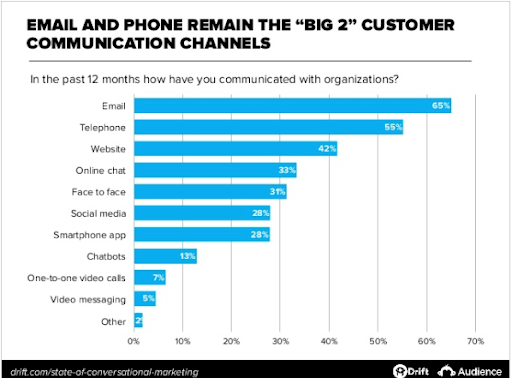
65% of respondents said that in the past 12 months they had used email to communicate with organizations, putting email head and shoulders above the rest.
Given the returns we receive from email, the trust it allows you to build between existing and potential customers and the ways in which it is set to develop into the next decade, it’s a channel that you should certainly feel confident investing in.
Data-driven marketing set to evolve
The technology in AI systems goes above and beyond anything email marketers have previously had access to, but there’s so much more we could be doing with our current systems and databases.
A/B testing is a fantastic means of optimizing the wording and content of your emails to provide the greatest possible levels of engagement and ROI. There is, however, a lot of room for improvement in the ways that many of us are using this form of testing.
It’s likely that you’re already using data-driven marketing in one way or another. Over time, simple tweaks to your email content – based upon previous performance – can help to drive extra clicks, downloads, forwards and signups.
But if you can start to look at “data-driven marketing” from a “customer-driven marketing” perspective, you can start to think how your customers think and create experiences that they will engage with.

Kath has lived and breathed email marketing for over 20 years. As Founder of Holistic Email Marketing, she devotes her time to developing customer-centric e-commerce journeys using a holistic, multi-channel approach.
“I’m predicting that in the Year 2020, that there will be an uptake in robust, hypothesis-led A/B testing. A methodology of testing where the marketer leads the test by forming hypotheses and then uses technology to perform the test, rather than letting the technology lead the test – as was done in days of old. Let’s be honest – we’ve all been there. You feel that you ‘should’ run an A/B Split test and so go to your technology, select to run a subject line test and out of thin air and with no research or hypothesis, throw together two subject lines to test. And then become disappointed because there wasn’t a winner due to the subject lines being too similar.
“To tell the truth, it’s not so much a prediction as reporting what I am currently seeing….and in my opinion it’s way overdue. There are multiple reasons as to why it’s taking off now, but one of the main reasons I’ve found is that email is finally being appreciated as a high ROI-delivering channel and people want to ensure they’re not leaving money on the table.
“Another key reason is to do with education of email marketers… or lack thereof. Email has always been one of those channels that marketers seem to ‘fall into’ on their way to doing something else, and as such historically most email marketers have learned all they know from their own experience – picking up things as they go on.
“Email marketing now offers credible career paths, and as such the modern-day email marketer is looking beyond just learning from their technology but are avidly reading, taking courses and asking questions in forums and sharing knowledge. They have a passion for improvement, which is driving them to look beyond the basic A/B split testing tools that ESP’s offer and question, ‘should I let technology lead my test or should I, the marketer, take charge?’”
The results (and rewards) to be obtained from A/B testing are entirely defined by your starting point. If this starting point is well thought out and you know the end goal that you seek to reach, you are more likely to design an A/B test that will drive higher levels of engagement.
From there, you’ll draw conclusions that can inform and improve your strategy moving forward, allowing you to generate even greater returns from email marketing’s already sky-high ROI.
Final thoughts
As technological innovation continues to reshape email marketing, it’s reassuring to know that there’s plenty you can do at every level of your strategy to improve results.
The way that different demographics are engaging with your emails is changing, and that should be the basis for how you decide to interact with your subscribers as we enter 2020.
One thing is clear: email marketing is here to stay.
